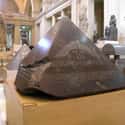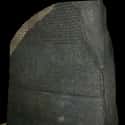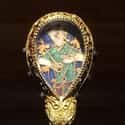-
(#4) The Pyramidion Of The Black Pyramid Of Dashur (c. 1820 BC)
Pyramidions were created to be the capstones of ancient Egytpian pyramids, and few have survived into the present day. This pyramidion was found in the rubble near the Pyramid of Amenemhat III at Dashur, which is sometimes referred to as the Black Pyramid.
Not much remains of the Black Pyramid today, due to poor construction methods that doomed the structure from the beginning. The granite pryamidion, however, is in relatively good shape, and its four sides still bear legible inscriptions. It is currently housed in the Egyptian Museum at Cairo.
-
(#12) A Jade Cong From The Liangzhu Culture (c. 3300-2200 BC)
Living in China's Jiangsu province in the third millennium BC, the Neolithic Liangzhu culture created items out of jade, ceramic, and stone that still exist today. Many "cong" objects have been found, exhibiting a circular inner shape and square outer section, but their use and significance remain mysterious. Several cong have been unearthed in Chinese tombs from the period.
Khan Academy describes these objects as "among the most impressive yet most enigmatic of all ancient Chinese jade artifacts." Also, they "were extremely difficult and time-consuming to produce. As jade cannot be split like other stones, it must be worked with a hard abrasive sand."
-
(#1) Rosetta Stone
- Relief
This giant slab of basalt is where the Rosetta Stone language-learning program gets its name. Discovered by Napoleon Bonaparte's army in 1799, the slab contains a decree from King Ptolemy V (r. 204-181 BC) written in three different languages: Egyptian hieroglyphic, Egyptian Demotic (the "language of the people"), and ancient Greek (the language of Egypt's Greco-Macedonian rulers).
As the British Museum explains:
The importance of [the Rosetta Stone] to Egyptology is immense. When it was discovered, nobody knew how to read ancient Egyptian hieroglyphs. Because the inscriptions say the same thing in three different scripts, and scholars could still read Ancient Greek, the Rosetta Stone became a valuable key to deciphering the hieroglyphs.
-
(#9) The Alfred Jewel (c. Ninth Century AD)
Discovered in a field in Somerset, England, in 1693, this royal relic dates to the reign of King Alfred the Great (871-899 AD) and bears the inscription "AELFRED MEC HEHT GEWYRCAN," or "Alfred ordered me to be made."
According to the Ashmolean Museum, the jewel was originally part of an aestel, or pointer, a device used to follow text in manuscripts. A "significant" piece of Anglo-Saxon goldsmithing, the aestel was crafted around a slice of rock crystal.
-
(#15) Shroud of Turin
Though its authenticity is a matter of fierce debate (and has been since it first emerged in the mid-14th century), the Shroud of Turin remains a powerful religious icon to many Christians the world over. Believed by some to be the burial shroud of Jesus Christ, the cloth has been studied extensively by scientists and religious scholars alike.
Today, the shroud is closely guarded behind bulletproof glass and seldom seen by the public. However, following the global turmoil of the COVID-19 pandemic, it was made available to view online in April 2020.
-
(#10) British Museum Royal Game of Ur (c. 2600-2400 BC)
Popular throughout the Mediterranean and the Middle East thousands of years ago, the Royal Game of Ur was a popular pastime for ancient peoples.
As Irving Finkel, the assistant keeper at London's British Museum in the Department of the Middle East, explains, "There were no entertainments for such a huge period of human existence. In that environment, games had a fantastically strong hold. They reigned supreme."
Time sums it up even better: "For centuries, even millenniums, the Royal Game of Ur served as the PlayStation of its day."
New Random Displays Display All By Ranking
About This Tool
While ancient times happened so long ago, some things never change. Over the years, archaeologists from all over the world have devoted themselves to excavating and exploring the history of human civilization. They have unearthed many valuable ancient cultural artifacts in a wide range, including tools, pottery, metal objects, personal items, etc. Cultural relics are relics and relics that reflect the material and spiritual culture of a nation.
The random tool shows 15 amazing artifacts from ancient times that reflect social development and social life from different aspects, and they are physical materials for studying the history of the ancient world.
Our data comes from Ranker, If you want to participate in the ranking of items displayed on this page, please click here.
















